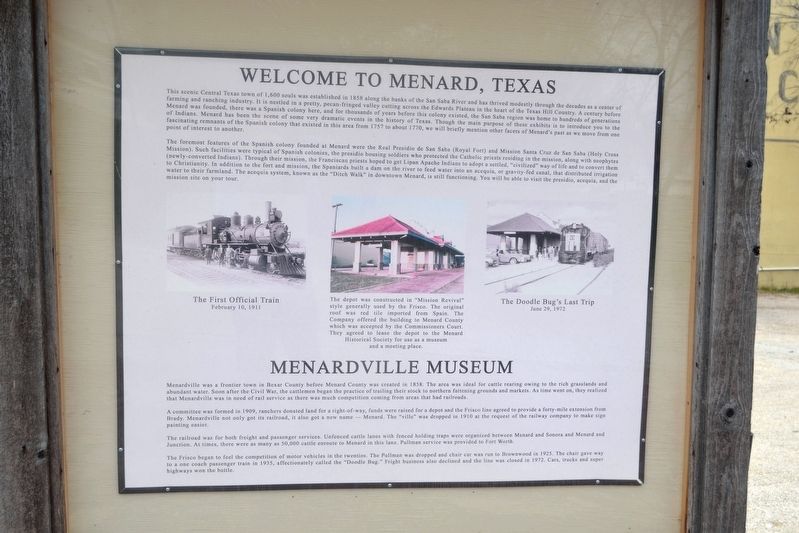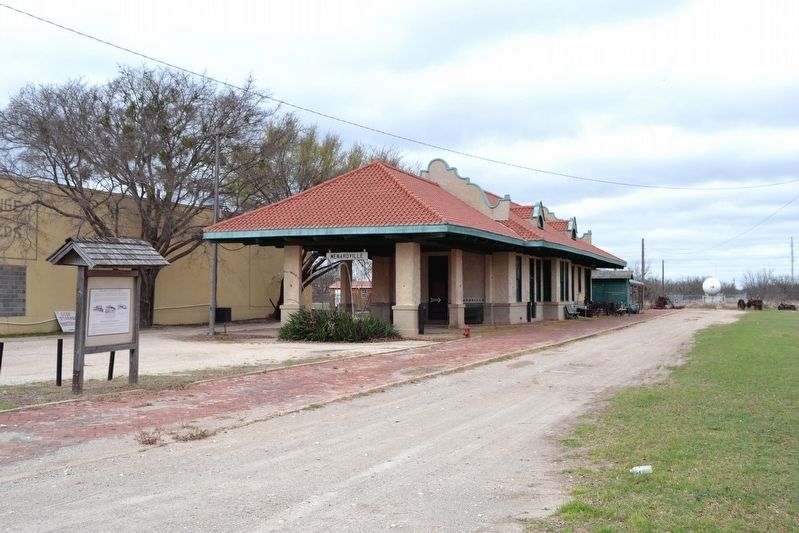Menard in Menard County, Texas — The American South (West South Central)
Welcome to Menard, Texas
Welcome to Menard, Texas
This scenic Central Texas town of 1,600 souls was established in 1858 along the banks of the San Saba River and has thrived modestly through the decades as a center of farming and ranching industry. It is nestled in a pretty, pecan-fringed valley cutting across the Edwards Plateau in the heart of the Texas Hill Country. A century before Menard was founded, there was a Spanish colony here, and for thousands of years before this colony existed, the San Saba region was home to hundreds of generations of Indians. Menard has been the scene of some very dramatic events in the history of Texas. Though the main purpose of these exhibits is to introduce you to the fascinating remnants of the Spanish colony that existed in this area from 1757 to about 1770, we will briefly mention other facets of Menard’s past as we move from one point of interest to another.
The foremost features of the Spanish colony founded at Menard were the Real Presidio de San Saba (Royal Fort) and Mission Santa Cruz de San Saba (Holy Cross Mission). Such facilities were typical of Spanish colonies, the presidio housing soldiers who protected the Catholic priests residing in the mission, along with neophytes (newly-converted Indians). Through their mission, the Franciscan priests hoped to get Lipan Apache Indians to adopt a settled, “civilized” way of life and to convert them to Christianity. In addition to the fort and mission, the Spaniards built a dam on the river to feed water into an acequia, or gravity-fed canal, that distributed irrigation water to their farmland. The acequia system, known as the “Ditch Walk” in downtown Menard, is still functioning. You will be able to visit the presidio, acequia, and the mission site on your tour.
Menardville Museum
Menardville was a frontier town in Bexar County before Menard County was created in 1858. The area was ideal for cattle rearing owing to the rich grasslands and abundant water. Soon after the Civil War, the cattlemen began the practice of trailing their stock to northern fattening grounds and markets. As time went on, they realized that Menardville was in need of rail services as there was much competition coming from areas that had railroads.
A committee was formed in 1909, ranchers donated land for a right-of-way, funds were raised for a depot and the Frisco line agreed to provide a forty-mile extension from Brady. Menardville not only got its railroad, it also got a new name — Menard. The “ville” was dropped in 1910 at the request of the railway company to make sign painting easier.
The railroad was for both freight and passenger services. Unfenced cattle lanes with fenced holding traps were organized between Menard and Sonora and Menard and Junction. At times, there were as many as 50,000 cattle enroute to Menard in this lane. Pullman service was provided in Fort Worth.
The Frisco began to feel the competition of motor vehicles in the twenties. The Pullman was dropped and chair car was run to Brownwood in 1925. The chair gave way to a one coach passenger train in 1935, affectionately called the “Doodle Bug.” Fright business also declined and the line was closed in 1972. Cars, tracks and super highways won the battle.
(Left Photo Caption)
The First Official Train - February 10, 1911
(Center Photo Caption)
The depot was constructed in “Mission Revival” style generally used by the Frisco. The original roof was red tile imported from Spain. The Company offered the building to Menard County which was accepted by the Comissioners Courts. They agreed to lease the depot to the Menard Historical Society for use as a museum and a meeting place.
(Right Photo Caption)
The Doodle Bug's Last Trip - June 29, 1972
Topics. This historical marker is listed in these topic lists: Colonial Era • Forts and Castles • Native Americans • Settlements & Settlers.
Location. 30° 55.448′ N, 99° 47.052′ W. Marker is in Menard, Texas, in Menard County. Marker is on Frisco Avenue (U.S. 83) north of U.S. 190, on the right when traveling north. Marker is at front of Menard Museum complex. Touch for map. Marker is in this post office area: Menard TX 76859, United States of America. Touch for directions.
Other nearby markers. At least 8 other markers are within walking distance of this marker. Frisco Depot (a few steps from this marker); Paso de la Santa Cruz (a few steps from this marker); Presidio de San Luis de las Amarillas (within shouting distance of this marker); Bank of Menard (approx. half a mile away); Great Western Trail (approx. half a mile away); Menard County Memorial of Those Who Died (approx. half a mile away); Fort McKavett C.S.A. / Texas Civil War Frontier Defense (approx. half a mile away); Oliver Prince Smith (approx. half a mile away). Touch for a list and map of all markers in Menard.
Credits. This page was last revised on March 31, 2018. It was originally submitted on March 31, 2018, by Duane Hall of Abilene, Texas. This page has been viewed 378 times since then and 36 times this year. Photos: 1, 2. submitted on March 31, 2018, by Duane Hall of Abilene, Texas.

